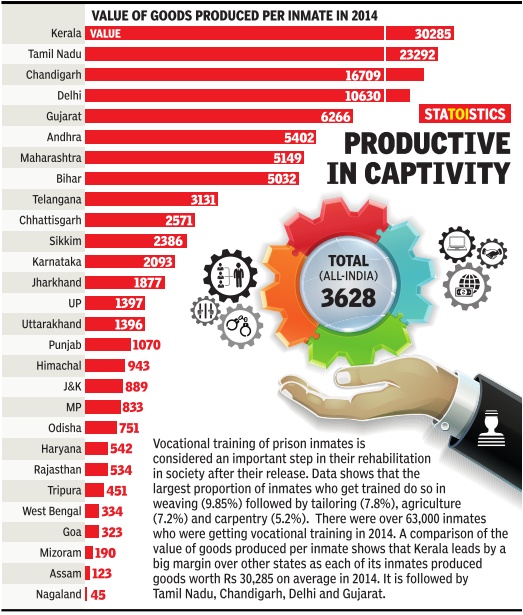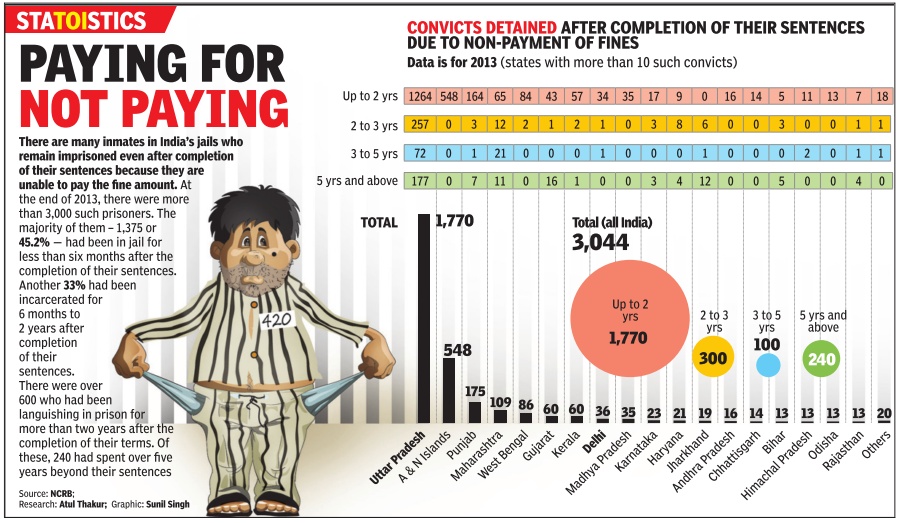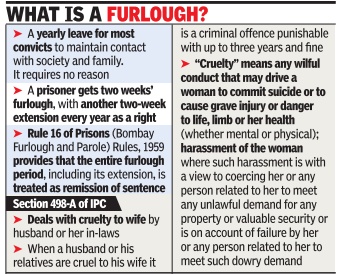Jails/ Prisons: India



Contents |
Overcrowding


Jails in UP, MP, Chhattisgarh most crowded
Deeptiman.Tiwary @timesgroup.com New Delhi

The Times of India Aug 19 2014
Overcrowding of prisons is often cited as the reason for inmates living in pitiable conditions. However, official data show prisons in almost 20 states have less number of inmates than their official capacity or are just at par.Actually a few states, including UP , MP, Chhattisgarh and Delhi, have skewed the national average with massive overcrowding their prisons.
UP alone contributes to overcrowding by close to 32,000 prisoners when cumulative overcrowding across the country stands at close to 42,000. In its 65 jails with a capacity of 47,518 inmates, UP has crammed 80,311. Chhattisgarh is another laggard state with its prisons overcrowded by 8,930 inmates against a capacity of 5,850. Delhi, whose Tihar jail has often been in the news for overcrowding, has almost twice the number of inmates against its capacity . Madhya Pradesh jails, from where six SIMI accused broke free last year, are overcrowded by over 7,000 inmates.
Curiously , Bihar is one of the best performing states along with Tamil Nadu in building optimum capacity in jails. While TN has almost 9,000 less occupancy against a capacity of 21,951, Bihar over 6,500 less inmates against its total capacity . Odisha is another state where prison capacity has improved over the years with almost 30% less occupancy against capacity
Much of these positive changes have come about in the past one decade when the Centre launched seven-year scheme worth Rs 1,800 crore for modernization of prisons. i In 2002, there were 1,135 jails t across the country with a capacity to hold 2,29,874 inmates.However, 3,22,357 inmates were t crammed in these jails. Between 2002 and 2012, number of jails increased to 1,394 with the capacity improving to 3,43,169.By the end of 2012, there were 3,85,135 inmates in these jails.
While number of inmates increased by close to 50,000 in this period, the capacity of prisons improved by over 1 lakh easing pressure on infrastructure and making life better inside jails.
Jailhouse deaths in Delhi, UP
Jailhouse deaths
By Anon, The Times of India, 12 March, 2013
India and the world: Prison population

Jun 15 2015
With 716 prisoners per lakh of people, the US has the world's highest incarceration rate. Among 190 countries for which data is available, India is ranked 183rd in terms of the incarceration rate. This rate is dependent not just on the crime rate, but also on urbanization, efficiency of the criminal justice system and marginalization of some sections.Thus, there is a huge difference in incarceration rates among coloured and white people in the US. In India, Muslims, Dalits and tribals constitute 53% of the prison population -much higher than their share in the population.
“Unnatural” deaths: 2013
The Times of India, Jun 12 2015

10 unnatural deaths occur in Indian jails every month
The murder of an inmate in Tihar is no isolated incident, with official data showing that there were 115 “unnatural deaths“ in India's jails in 2013, the latest year for which data is available from the National Crime Records Bureau. That's about 10 unnatural deaths every month. At 5.9 unnatural deaths per 10,000 inmates, Delhi's jails clock more than twice the national rate of 2.8 per 10,000 inmates. Whether this has anything to do with Delhi jails having over twice as many inmates as they are supposed to hold, against a national average of 118% occupancy, is a moot question.
The NCRB's prison statistics in India 2013 shows that of the 115 deaths due to unnatural causes, more than half (70) were officially classified as suicides, 12 were attributed to “assault by outside elements“ and eight to murders by inmates.With one execution and one death due to firing, the causes of deaths of 23 “others“ have not been spelt out.
The highest rates of unnatural deaths (per thousand inmates) were in Jammu & Kashmir, Tamil Nadu, Assam, Delhi and Rajasthan in that order. The lowest rates among bigger states were in undivided Andhra Pradesh, Bihar, Odisha, Maharashtra and Jharkhand. The prison statistics also show that barring Chhattisgarh, a state severely affected by Maoist insurgency , Delhi had by far the most overcrowded jails in the country . Chhattisgarh had 15,840 inmates in its jails which had a capaci ty of just 6,070, thus recording an `occupancy rate' of 261%. Delhi's 13,552 inmates were stuffed into jails meant to hold 6,250 people, an occupancy rate of 217%.The national average occupancy rate was about 118%, which shows that while jails as a rule are overcrowded in India, Delhi's prisons are almost twice as congested as the average.
CCTV surveillance
The Times of India, Jul 24, 2015
Put all prisons under CCTV camera surveillance: SC to govt
Amit Anand Choudhary
In a landmark verdict to ensure protection of human rights of prisoners, the Supreme Court on Friday directed the Centre and all state governments to put prisons under surveillance of CCTV cameras.
A bench headed by Justice TS Thakur also directed the states which have not set up Human Rights Commission to form the panel as soon as possible. There are many states and Union Territories like Himachal Pradesh, Meghalya, Nagaland, Arunachal Pradesh, Delhi, which have so far not set up the human rights watchdog panel. The court also asked the state governments to consider installing CCTV camera in police stations and lock ups to ensure that people are not subjected to unnecessary torture. It also directed that there must be two women constable in each police station.
Furlough (discretionary leave) for convicts

The Times of India, Sep 02 2015
Swati Deshpande
30-day parole to Dutt raises questions
Experts wonder whether jail authorities applied their mind in deciding his plea
Furlough is discretionary leave that convicts are allowed to enable re-integration with society upon their final release. It requires no specific reason. But parole is leave granted for a specific reason. It is not counted towards days served in prison, unlike furlough.
The jail manual requires a plea for parole to be processed within 45 days after it is made.The convict files and sends a parole plea to the jail superintendent, who forwards it to the divisional commissioner.The decision includes seeking a police report and communicating approval or rejection to the convict.
Delay in decision-making raises pertinent questions about whether prison authorities apply their mind, said a lawyer. Many lawyers say while the delay has come to light in Dutt's case, many applications remain pending for months, unnoticed and forgotten. “The rule book must be followed strictly as the high court has ruled in several cases,“ said advocate Farhana Shah, who has represented many convicts whose parole pleas were not decided for months. She said while Dutt's leave was “rightly granted“, though delayed, the “same consideration“ should be made for other inmates whose pleas are later rejected on the grounds that the reasons are no longer relevant. “If a parole plea is decided, for instance, after the marriage of the child of a convicted prisoner (for which leave was sought), it would defeat the very purpose,“ she said.
“If a plea is not decided in time, an extension plea would be rendered meaningless,“ said another lawyer, adding that even for furlough, the authorities are expected to verify the convict's conduct and record and only then grant leave.
Bihar
India Today, February 3, 2016
Amitabh Srivastava
Bihar's jails are the new nerve centres of crime, offering a safe haven for gangsters to operate from.
In June 2015, the authorities at Sheohar divisional jail allowed a strange, joint "register entry", a process allowing undertrials to visit the jailer's office to deposit money. The people involved were an under-trial couple-kidnapping accused Puja and her gangster husband Mukesh Pathak-and, according to prison records, they parked some Rs 15,000 rupees with the office. But that wasn't all they were doing there. With the authorities looking the other way, the two apparently used the assistant jailer's office to pursue "physical relations". Only a select few, the top bosses of Sheohar jail, knew of the arrangement. But the fact was outed when, during a regular medical check-up in September, the doctor declared Puja pregnant. While the Sheohar jail officials tried to hush it up, it couldn't go on forever. Once the name of Mukesh Pathak-now roaming free after his daring escape last year-surfaced as the main accused in the December 26 killing of two engineers at Darbhanga, the police started digging deeper. Soon, the details of his in flagrante proclivities in jail tumbled out.
The facilitators
The prisons in Bihar have always had an unsavoury reputation, but of late things have taken a turn for the worse. Many known criminals now rush to surrender in the courts after committing a crime, which suggests they find the going better in jail than on the run. And what's not to like? Jails are safe havens, and since they have surrendered, it prevents confiscation of property and makes it easier to post bail. In September 2014, a joint report of the DM and the SP in Sitamarhi revealed how a select group of prisoners was allowed to avail facilities like ACs, coolers and mobiles. Even marijuana and liquor were provided to the "privileged" ones, it said. All this when the number of CCTV cameras have gone up, jails are less crowded, and the media is more active than ever. None of this has acted as an deterrent. And while the report did raise eyebrows, it has been conveniently buried. Take the Mukesh Pathak case, for instance. Pathak married Pooja in Sheohar jail in October 2013, after obtaining prior court permission. Jailer R.N. Shafi had then played the role of the girl's father and even performed the kanyadaan. Last year, after the jailer's office incident, the groom complained of medical issues and was promptly shifted to the government hospital in Sheohar from where he escaped on July 20 after drugging his guards. The irony here is the resultant inquiry did not even question the doctor who recommended him to hospital nor those who 'treated' him there for a week. (You can't blame the doctors either. In 2011, jail Dr Buddhadeo Singh was beaten to death in Gopalganj district jail after he refused to issue a fake medical certificate. According to latest NCRB figures, Bihar jail inmates made 7,051 visits to hospitals for "medical reasons" in 2014.) It's been four months since Puja's pregnancy was detected in September 2013, and an 'internal probe' is yet to conclusively establish anyone's guilt. IG prisons Prem Singh Meena says the probe has revealed "three dates when the couple could have had a private meeting (leading to her pregnancy). One such day was when they visited assistant jailer's office. The assistant jailer, head warden and warden of Sheohar jail have been served a show cause notice. We will take action once we get their response". Jha's gang is not an isolated example. Bihar's jails are the new hunting ground for criminals on the make. One of the reasons is also the low conviction rate. When it comes to percentage share of prison inmates, Bihar today has the lowest share of convicts (14.2%) against undertrials (85.6%)- the national average ratio is 31.4% convicts to 67.6% undertrials. This is also indicative of another fact. The number of arrests has gone up, and so has the number of police cases. But one of the worst conviction rates in the country means it is no deterrent to major crime. (In fact, criminals prefer the jail route nowadays than taking the police head-on. In 2001, the number of police 'encounter' deaths in shootouts stood at 41. The number dropped to two in 2015.) All this breeds a vicious circle. Once the police arrest a hardened criminal, he is produced in court that remands him to judicial custody. But, once the accused reaches jail, he starts operating with impunity from there. It leads to a horrific conclusion: higher the arrests, higher the crime. So it holds true that the jails-headed by a pliant gang of prison officials-have defeated the very purpose for which they were created. Bihar's jailed bahubalis are as active in this as your common variety don. In 2015 itself, independent MLC Ritlal Yadav, MLA Anant Singh, former RJD MP Shahabuddin have all had fresh FIRs filed against them for "jail violations". Leader of the Opposition, the BJP's Prem Kumar, says, "A majority of criminal cases committed in Bihar are linked to jails. Prison officials are either being pressured or are hand-in-glove with inmates. CM Nitish Kumar mans the home portfolio, he has to set things right fast or admit the situation is outside his control."
Killings ordered from jail
The Darbhanga murders of the two engineers, Brajesh Kumar Singh and Mukesh Singh, happened after their Gurgaon-based construction company, currently building a 120-km stretch of the Begusarai-Darbhanga state highway, refused to pay extortion money. The project, nearly halfway through, is worth Rs 700 crore. Police sources say the construction company was asked to cough up 10 per cent of the project cost as extortion money. The killings, which immediately put a question mark on the fate of big ticket projects in Bihar, and the investigation trail, led the police to another jail. Santosh Jha, mastermind of a flourishing extortion racket in Bihar and Mukesh's boss, was cooling his heels in Gaya central jail. Jha was in touch with hitmen via mobile phone and issuing elaborate orders via Facebook messenger, one of which was to bump off the two engineers. The extortion cell Santosh Jha, 40, an ex-Maoist-turned-criminal, has over a dozen cases of murder, extortion, kidnapping and one of even 'landmine explosion' against him. He's believed to have extracted several crores from some of the major construction firms in Bihar. One of the new breed of tech-savvy criminals, Jha operates under the facade of a 'People's Liberation Army', which targets road contractors in north Bihar and affluent businessmen of Nepal. He mostly enrols his castemen as gang members and is said to have collected levies from over 1,000 people in north Bihar and Nepal. At least, six engineers have been killed in Bihar in the past for not caving in to the demands of the gang. Though Jha, who was arrested from West Bengal in June 2014, was lodged in Gaya, it was his influence which helped Pathak lord it over the Sheohar jail authorities. Police investigations have revealed that besides being in touch with gang members through FB, Jha even paid a fixed salary to his seven sharpshooters using net banking. Seized documents so far pertain to 25 bank accounts belonging to Jha's shooters. A dozen ATM cards belonging to gang members have also been seized. This is not a problem relating just to the Jha gang. Despite repeated recommendations, the prisons department is yet to instal jammers in any of Bihar's 58 jails while all agree that inmates using mobile phones has emerged as the single biggest reason for the spurt in crime. This also explains why Chief Minister Nitish Kumar's zero tolerance against crime has failed to have the desired effect in Bihar. K.C. Tyagi, Rajya Sabha MP and JD(U) spokesperson says, "The government has taken note of the rising criminal incidents with links to jails in Bihar. Nobody, including jail officials, will be spared if found guilty of irregularities." All the talk, though, will have to backed up by action. Considering Bihar's history and the spurt in violent crime in the last six months, that'll be no easy task.



